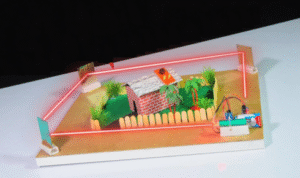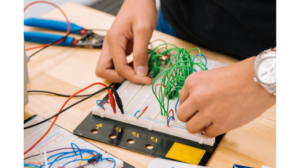1. What is the first step in building an AI model?
Answer: The first step is defining the problem you want to solve. Clearly understand the problem’s requirements, objectives, and desired outcomes before choosing a suitable AI approach.
2. What programming languages are best for building AI models?
Answer: Python is widely used as it has more number of libraries including TensorFlow, PyTorch and scikit learn. It’s easy to handle. R also is in favor of statistical computation.
3. What is Machine Learning?
Answer: Machine Learning is the set of techniques based on algorithms training on data or patterns so the machine learns like humans do; it can tell what the model will look at without programming at all. In fact, that is the primary technique in using AI models.
4. What is deep learning, and how does it compare to machine learning?
Answer: Deep learning is an enhanced area of machine learning, where artificial neural networks contain more than two layers, which will process all that large amount of data, and it is more about some of the images, speech recognition, and other even more complex tasks.
5. How do I gather data for my AI model?
Answer: You can gather data from public datasets, APIs, web scraping, sensors, or user-provided data. Ensure the data is clean, relevant, and representative of the problem you’re solving.
6. What is data preprocessing, and why is it important?
Answer: Data preprocessing is the cleaning and transformation of raw data into a usable format. This includes handling missing values, normalizing data, removing outliers, and encoding categorical variables. Proper preprocessing ensures better model performance.
7. What kinds of data are used for training an AI model?
Answer: AI models can be trained using various types of data, such as text, images, audio, or numerical data. The type of data depends on the problem you’re solving (e.g., text classification, image recognition).
8. What is labeled data?
Answer: Labeled data refers to the data that is labeled with the right output or label. For instance, for a classification problem, labeled data would be the input features with their corresponding class labels.
9. What is the difference between supervised and unsupervised learning?
Answer: In supervised learning, the model is trained on labeled data. In the case of the output, the desired output is given. The model works on unlabeled data in unsupervised learning. The model itself needs to figure out patterns or groupings.
10. What is overfitting in machine learning?
Answer: Overfitting is the phenomenon where a model learns the details and noise in the training data to the point that it performs poorly on new, unseen data. This can happen when the model is too complex relative to the amount of data.
11. How do I avoid overfitting?
Answer: Use cross-validation, regularization, like L1 and L2 regularization, or prune your network; you could simply reduce the size of your model. And getting more training data helps avert overfitting.
12. What are training set and test set?
The former is used in training the model, and the latter is reserved for testing with unseen data for the model performance. Usually, the data sets are divided: 80-20, such that 80% is put into the training set and the remaining 20% into a test set.
13. Explain what features and labels are to a machine learner.
Answer: Features are the input variables (e.g., age, income, temperature), and labels are the output or target variables (e.g., classification labels, numerical values to predict).
14. How do I evaluate the performance of my AI model?
Answer: The performance can be evaluated using metrics such as accuracy, precision, recall, F1 score (for classification), or mean squared error (for regression). The choice of metric depends on the task.
15. What is cross-validation?
Answer: Cross-validation is a method to check how well a model generalizes. It divides the data into a number of folds and trains and tests the model on different combinations of those folds.
16. What is a neural network?
Answer: A neural network is a computational model based on the brain. It contains layers of nodes, or interconnected neurons, which process data like humans do in processing information.
17. What is a CNN?
Answer: CNNs are a form of deep learning model primarily used for processing visual data. They are designed to automatically detect patterns, edges, and features in images, which makes them very good for applications like image classification and object detection.
18. What is a recurrent neural network (RNN)?
Answer: RNNs are a type of neural network designed for sequential data (e.g., time series, text, speech). They have feedback loops that allow them to maintain information from previous steps, making them useful for tasks like language modeling and speech recognition.
19. What is the role of activation functions in neural networks?
Answer: Activation functions introduce non-linearity into the network, which enables it to learn complex patterns. Common activation functions include ReLU (Rectified Linear Unit), sigmoid, and tanh.
20. What is gradient descent?
Answer: Gradient descent is an optimization algorithm used to minimize the loss function in machine learning models. It iteratively adjusts the model’s parameters (weights) to find the values that reduce the error between predicted and actual outputs.
21. What are hyperparameters? How do I select them?
Answer: Hyperparameters are settings controlling the training process, such as the learning rate, batch size, and number of layers. They are often selected by experiments or methods like grid search and random search.
22. Difference between classification and regression?
Answer: Classification involves the use of input data to classify the same into a pre-defined category or class. In regression, one aims to predict a continuous numerical value based on input data.
23. How do I deal with missing data in my AI model?
Answer: Missing values can be dealt with either through imputation, such as filling missing values using mean, median, or mode, or algorithms that can directly take missing values (for example, decision trees).
24. What are the best tools and frameworks for developing AI models?
Answer: Some of the most widely used tools or frameworks to develop AI models include TensorFlow, PyTorch, Keras, scikit-learn, and XGBoost. These frameworks provide available functions for training and evaluating, optimization of a model.
25. How do I deploy the AI model in a real-world application?
Once you have trained and tested your model, deploy it using AWS, Google Cloud, or Azure. You can put the model within applications through APIs, or even through containerization, such as Docker, that make it available to others or systems.








